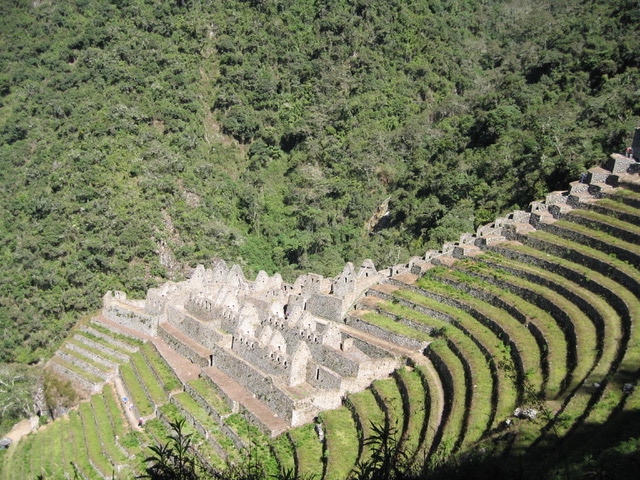First stop: Cuzco - ancient capital of the Inca Empire, now a charming town of shops and restaurants along narrow cobblestone streets.
The beautiful central square has an ornate cathedral and Peruvians selling Quechuan handicrafts and artwork. This is where we bought a watercolor from a street peddler.
The farmers' market in Cuzco had beautiful fruits ad vegetables, as well as various meats hanging in the open and women sitting on the floor selling teas and herbs.
Day 2: A statue of Christ on a ridge can be seen over the red-roofed houses of Cuzco. In the next photo, we're up close as we visit Inca ruins.
This is only a small portion of the majestic Sacsayhuaman fortress. Immensely impressive with its perfectly fitted, mortarless stone blocks and zigzag walls which are about 200 feet tall.
Day 3: Our first big hike in Pisac was mostly flat terrain, as we acclimated to the almost 12,000-foot elevation. We saw beautiful Inca stonework as we maneuvered stairs, walkways and trails with 2,000-foot drops to our side.
Day 4: Our second big hike was after a picnic lunch in Maras, to the salt pans of Salinas, fed by a salt spring that flows into terraced evaporative pools as a way of harvesting salt. Amazing - acres and acres - we (very carefully!) walked along 12-inch wide salt-covered paths between the pools.
The Incas dug concentric terraces to farm. This was an "agricultural experiment station" where they planted crops in different microclimates to determine the best growing conditions - more than 700 years ago! Look carefully in the upper mid/left terrace - those are people restoring a portion of the wall.
Paul has a new best friend at a llama and alpaca farm.
In the market town of Chinchero (at 13,000 feet high), a Peruvian family showed us the ancient traditional process for cleaning, dying, spinning and weaving alpaca and llama fur into beautiful blankets and artwork.
On the edge of the village overlooking the farming terraces, the villagers sell their handicrafts from blankets spread on the ground.
Chinchero is famous for a massive Inca wall and terraces.
As we were taking pictures of the terraces and vistas, several farmers were escorting a line of hay-carrying donkeys.
Day 5: We took a train through the gorge of the Urubamba River ...
... and got off at Kilometer 104 to start our hike on the Inca Trail to Machu Picchu.
The Andes Mountains are magnificent!
We hiked steadily uphill to the jungle-bound ruins of Winaywayna, discovered in 1941.
Yes, we have hiked to and through Winaywayna, and are are now looking back down at it from far above ... the steps leading up the mountain from it can be seen on the previous photo ...
... and if you're climbing them, it looks like this ... what a challenge (after several hours of "steady-up" already)!
We stopped for a group photo inside one of the houses in Winaywayna. We're all smiling, but we're all tired. That's Carol, Paul and me, Barry and Caroline and their two daughters, Laurie, and our guide, Manuel.
Not much rest for the weary!
The Inca Trail cuts across the ridge above the Machu Picchu ruins. These are our first views from Intipunku - the Gate of the Sun.
Intipunku is about 1,500 vertical feet above Machu Picchu. In this photo, note the small sunny ledge where people are standing in the lower left corner ...
... that's where Paul and I are kneeling. We're glad we made it! And that it's all downhill from here!
The view is breathtaking. Our group gathered together to celebrate the day and the moment.
Days 5-7: The following photos were all taken as we approached, or explored up close, the ruins of Machu Picchu.
Paul and me with our wonderful guides, Wilfredo and Manuel.
This trail led out to the "Inca Bridge," an ancient drawbridge leading to the jungle. Just over that narrow edging of plants is a sheer drop off the mountain ... over 2,000 feet!
This statue of the Inca is in the town of Machu Picchu ... about 5,000 vertical feet (and a very interesting bus ride) below the ruins.
Day 8: We spent our final day in Lima, the capital of Peru. This huge statue of two lovers is in a park on the coast.
Far below the statue, surfers enjoyed the waves.
Downtown Lima has a European feel ...
A beautiful ending to a magnificent adventure!
***THE END***













































